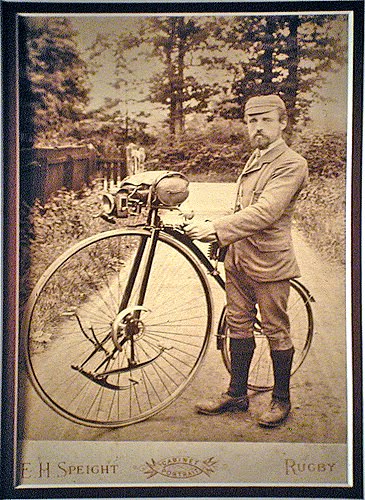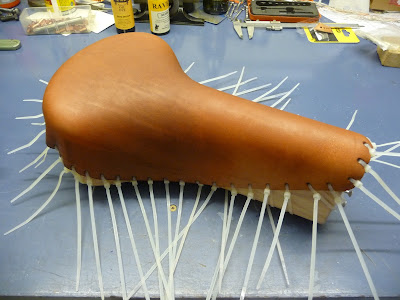Assorted shipments have arrived and so work on the saddle can resume. You may recall that I'm following the advice of Tim, who is an expert at this stuff. The first thing to do is to obtain half a cow. And not just any old half of a cow either. I don't actually need half a cow but this is the smallest amount I can obtain directly from the supplier and I'm sure it will get used. Tim gave his recommendations for the type of leather I needed and I was almost able to obtain what he advised. The important bit is that the leather is naturally tanned (with oak bark etc.) and is suitably thick. Chrome tanned leather (most leather is tanned with chromium salts) won't do at all, it won't move enough when stretched over the block and won't retain the new shape when dried. Also the part of the animal is important too. Tim advises using the butt rather than the shoulder as it will stretch less when complete and will be more durable. Also, as every female on the planet knows, the butt is thicker than the shoulder.
Half a cow, yesterday.
My hide was produced by Chahin tannery in Mexico, it is 6 mm skirting, Tim thinks that this is too thick and has suggested ways of thinning it. Since I have so much leather, I'm going to try at full thickness first and then do it again if it doesn't work well. It's all a new learning experience for me.
The orientation of the saddle on the hide is also important, it needs to run vertically, up the animals side rather than along it's back. This is again to prevent unwanted stretch.
Brooks saddles are moulded under high pressure as in this short film at (6:00). Do make sure you watch part two as well. Obviously my shed doesn't run to such tooling so I need to do it manually.
The first thing to do is to make the wooden block that the leather will be moulded over. When I did this previously I used one large piece of timber and carved it out. I used a lump of oak just because I happened to have it lying around. This was hard work and I wouldn't recommend it. So this time I decided to laminate the block from planks of pine, this has a big advantage that I'll get to in a minute.
Cutting out the laminates.
First mark the outline on the planks and then jigsaw them out. I used a coping saw just because I'm a retro grouch and like doing stuff by hand. Actually, I can't easily get blades for my jigsaw, it being an older model bought in England many years ago and now residing in NZ.
Glue them all together and clamp it up for 24 hours.
Clean up the profile before doing any shaping.
I found that large metal working bastard files were better than a wood rasp designed for the job.
Then start to shape the block to match the saddle cantle plate and nose piece.
Finally when you are happy with the shape, varnish the block to protect it from moisture.
A Brooks B70 has deep side flaps so I made my block quite deep to allow for this.
Now we need a way to stretch the leather over the block. When I did this previously I punched a series of holes around the perimeter of the leather and then threaded cord through the holes. By using a series of wedges I was able to tighten the cord. This wasn't very satisfactory and the tension in the cords wasn't easily adjusted. I hit upon the idea of using adjustable tenterhooks. Once again punch the series of holes around the circumference and then screw a series of wood screws around the base of the block. The leather can then be stretched by threading zip ties through each hole and around a screw head.
Tenterhook tensioning technique.
Next dunk the leather in some warm water. You will see air bubbles rising out of the edges and face of the leather, You need to keep it in the water until all the bubbles have stopped and then a bit longer for good measure. I left it in for an hour as Brooks do but that is probably overkill. When you take the leather out of the water it has a rubbery, gooey feel to it.
So now strap it down onto the block with the zip ties, it is possible to massage the leather down to conform to the shape of the block and then tighten the zip ties to hold it in place. Due to the thickness of the hide and the three dimensional nature of my block this is not a quick process and it is quite hard to completely remove the bulge on the top of the saddle. It would probably be easier with two people. One to massage the leather down the sides and the other to tighten the straps at the same time.
I'm going to buy shares in a zip tie company.
This whole process took me an hour and a half from getting the leather out of the water to having the leather tightly conforming to the block. Tim has recommended a specific type of dye to use when the leather is still wet, so the next step is to make a dauber (I made it earlier from cotton wool wrapped in cotton cloth) and give the saddle a number of coats until the desired colour is achieved. Then leave it to dry.
So far so good, but now the skilled bit starts.
To be continued...
<out of character rant>
In other news, we have had two cyclists killed this week in Christchurch. My thoughts are with both families, really they are. In recent months I've started to notice a worrying tendency for the press to report on the clothing choices that dead cyclists make. In both cases the cyclists were wearing helmets which is a legal requirement here in NZ, this was duly reported. Also noted was the fact that the cyclists were not wearing high visibility clothing. It appears to be a subtle shift in the blame process. Note that both collisions, I won't call them accidents, were in bright daylight in dry conditions and within 1 km of each other. The cyclists are effectively being partially blamed for being killed by not dressing like a Christmas tree. Do all cars have to be painted bright orange? Is the colour of cars involved in collisions noted in the press? With all the post earthquake roadworks, demolition and building going on in Christchurch, at least half of the population of the city and most of the road network are swathed in bright orange traffic cones and high visibility jackets. This has become the new normal and consequently a cyclist does not stand out anymore.
New Zealand driving standards are very poor when compared with developed countries. Factor in the national sport of drink driving and you arrive at the shameful road toll that we have. Until people start to drive with some awareness and empathy, things will not improve.
I'm not holding my breath.
</out of character rant>




























